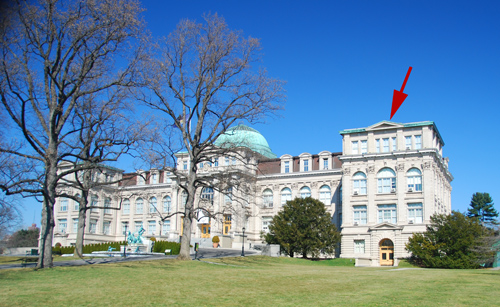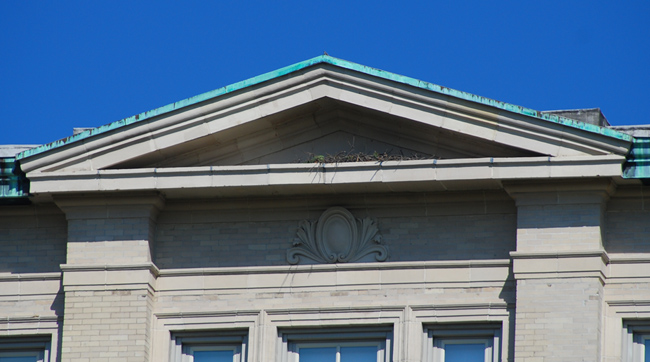Morning Eye Candy: Ducks on the River
Posted in Photography on December 22 2010, by Plant Talk
The Bronx River teems with ducks at this time of year.
Ducks on the Bronx River (photo by Ivo M. Vermeulen)

Inside The New York Botanical Garden
Posted in Photography on December 22 2010, by Plant Talk
The Bronx River teems with ducks at this time of year.
Ducks on the Bronx River (photo by Ivo M. Vermeulen)
Posted in Photography on December 16 2010, by Plant Talk
In the mornings, when we’re all exiting the train at Botanical Garden Station, this stand of pampas grass is all atwitter with a flock of sparrows that call it home.
Pampas Grass (photo by Ivo M. Vermeulen)
Posted in Photography on November 26 2010, by Plant Talk
| Ann Rafalko is Director of Online Content. |
The holidays are photogenic: all those sparkling lights and (glögg-induced) rosy faces! It’s a time that screams for grampa to pull out his old film camera, for auntie to stick a Flip in your face, and for mom to beg the entire family to pose in those special reindeer sweaters she managed to find in everyone’s size. But not every holiday photo need be awkward.
Here at The New York Botanical Garden we’ve got photo ops aplenty, and they’re all beautiful! But there’s no need to take our word for it. Just ask any of the 250 members of The New York Botanical Garden group pool on Flickr. Or, better yet, take a look at some of the beautiful photographs that our visitors have posted on their own! And then, if you like what you see, you can join the group (by signing up for Flickr) and begin uploading your own shots from around the Garden.
Posted in Programs and Events, Wildlife on April 24 2009, by Plant Talk
Expect Warblers, Wood Ducks, More on this Weekend’s Bird Walks
 |
Debbie Becker leads a free bird walk at the Garden every Saturday from 11 a.m. to 12:30 p.m., beginning at the Reflecting Pool in the Leon Levy Visitor Center. This weekend, she’ll also lead a walk on Sunday, same time and place. |
The phoebe, spring’s harbinger, has been singing its wonderful namesake song throughout the forest. Wood thrush are chiming in along with white-throated sparrows, tufted titmice, and cardinals.
While some birds are singing to lure a mate, some of our larger predators are already proud parents. Our red-tailed hawks appear to have one baby in their nest, built on a cliff-like shelf of the Library building. Mom and pop can be seen flying in and out with tasty morsels to feed the nestling.
Our baby great horned owls fledged their nest in the Forest. Last Saturday, only one baby was left in the nest (see photo) with Dad watching over him like a hawk (or should I say owl). The other owlet was somewhere in the Forest with Mom, learning how to fly and watching her hunt. Earlier this week, the second baby also fledged and now birders are treated to a spectacular show of watching them flap their brand-new wings and hop from branch to branch.
Warblers are beginning to invade the Garden. Some birders I know save all their vacation days for the last week of April and first week of May to look for these gems. Warblers are small, colorful birds that migrate from as far south as South America to the far northern reaches of the United States and southern Canada. Escaping predators and feeding on newly hatched insects, they travel up the eastern coast in the tens of thousands every April and May to their breeding grounds. This is the only chance each year to see these long-distance travelers in their brilliant breeding plumage, and birding NYBG gives you every opportunity to observe them. Last Saturday’s walk yielded a palm warbler, pine warbler, and yellow-rumped warbler.
To learn more about the birds at the Botanical Garden…
Posted in Wildlife on March 31 2009, by Plant Talk
Posted in Programs and Events, Wildlife on March 27 2009, by Plant Talk
Saying Hello to New Arrivals and Goodbye to a Friend
 |
Debbie Becker leads a free bird walk at the Garden every Saturday from 11 a.m. to 12:30 p.m., beginning at the Reflecting Pool in the Leon Levy Visitor Center. |
 Spring has sprung at NYBG. The phoebe, spring’s harbinger, has arrived. A beautiful phoebe was spotted down by Twin Lakes bobbing its tail and calling. Ruby-crowned kinglets, brown creepers, and a juvenile eastern kingbird were also spotted on last Saturday’s walk.
Spring has sprung at NYBG. The phoebe, spring’s harbinger, has arrived. A beautiful phoebe was spotted down by Twin Lakes bobbing its tail and calling. Ruby-crowned kinglets, brown creepers, and a juvenile eastern kingbird were also spotted on last Saturday’s walk.
Perhaps the best indication of spring is seeing the mating rituals that some of the birds perform. The male mockingbird does a dance on the lawn by extending his wings and flashing his white stripes. The female, who looks exactly like the male, is an onlooker who watches from afar. She may judge him on his display or wait further to hear the kaleidoscope of songs that emanate from his vocal cords when he is high atop a tree. Many mockingbirds mock sounds they hear in their vicinity. NYBG mockers often imitate the other birds at NYBG along with alarm systems from cars and sometimes screeching—like the sounds a child might make. The female only mocks in the fall, leaving the spring air open for her suitor’s song.
Read more about birds at the Garden and check out all of this weekend’s programming after the jump.
Posted in Wildlife on March 24 2009, by Plant Talk
  |
Wayt Thomas is the Elizabeth G. Britton Curator of Botany in the Institute of Systematic Botany. Stella Sylva is Administrative Curator in the William and Lynda Steere Herbarium. |

For the past several weeks a pair of red-tailed hawks (Buteo jamaicensis) has been building a nest on the Library building. Their nest is in a small triangular alcove near the top of the front face of the building on the east side (see photos)—they swoop by our office windows on their way to and from the nest.
Last year they started building a nest here but changed their mind and went elsewhere—Fordham University, according to Debbie Becker, who leads the Saturday morning bird walks at the Botanical Garden. This year the hawks seem to be serious. Two weeks ago they were engaged in a very active courtship display and mated several times a day.

Red-tailed hawk pairs are monogamous, with females (2–4.5 lbs.) larger than males (1.5–3 lbs). The adults have a dark brown back with a pale underbelly and a darker band across the belly; the tail is brick-red above and pinkish below. Our pair is unusual in that they are accompanied by a third hawk—rarely, a second female may help tend the nest and feed the young. This immature bird is an offspring of the pair’s from last year. If everything proceeds according to what we know about these hawks, 1 to 3 eggs will be laid in late March or April—we’ll keep you posted.

Red-tailed hawks usually feed on small mammals or birds and their preferred habitat is a mix of forest and open areas, such as we have here on the Garden grounds. Their diet consists primarily of squirrels, pigeons, small birds, and rabbits. We don’t know if they are part of the Garden’s Integrated Pest Management plan, but there are fewer squirrels than usual in front of the Library building.
Posted in Programs and Events, Wildlife on February 20 2009, by Plant Talk
Birders Treated to Uncommon Sightings and Start of Mating Season
 |
Debbie Becker leads a free bird walk at the Garden every Saturday from 11 a.m. to 12:30 p.m., beginning at the Reflecting Pool in the Leon Levy Visitor Center. |
 The other day I watched two male house sparrows competing for the attention of a female bird who seemed totally disinterested in their mating dance. With tail feathers extended they jumped, hopped, and vied for her attention. She seemed distracted and eventually flew away leaving the two male birds confused and looking for another female to shower with attention.
The other day I watched two male house sparrows competing for the attention of a female bird who seemed totally disinterested in their mating dance. With tail feathers extended they jumped, hopped, and vied for her attention. She seemed distracted and eventually flew away leaving the two male birds confused and looking for another female to shower with attention.
February marks the beginning of spring for many birds. It is the start of their mating season. Even though the temperature is hovering around 30 degrees and remnants of snow are on the ground, for birds love is in the air. Perhaps Valentine’s Day was created with birds in mind. What reasonable human really thinks about love during the coldest month of the year? Roses wilt, balloons deflate, and chocolate gets hard in the February frost. But for birds, their warm little bodies and courtship rituals begin to stir as tiny buds form on early blooming trees.
Bird watching has long been regarded as an act of love. For those of us who bundle up in the winter and drudge along snow-laden pathways in the Garden, it is a yearning of the heart that keeps us warm and drives us on. Our quest to see the owls, hear the mourning doves cry, watch the red-tailed hawks soar above, and feed the chickadees from our palms are all acts of unselfish and undying love. What else would motivate us to wake up early on a Saturday morning, don layers of clothes, gloves, boots, hand warmers, hats, and scarfs to brave the cold winds of February and March to go birding.
This year especially, the birding lovebug has bitten many. Because of the global changes and an unusually cold winter, many birds that normally are residents of Canada and the northeastern United States have been driven south by snow and an inability to find food. Much to the delight of birders in New York City and Long Island, white-winged crossbills, snow buntings, lapland longspur, pine siskins, snowy owls, snow geese, long-eared owls, and northern saw-whet owls, and bald eagles have been visiting our area. Earlier this month in the Garden 15 white-winged crossbills delighted a large group of birders with their chatter and acrobatic behavior as they hung from pine cones searching for food. We ran after them as they flew from tree to tree, careful not to slip on the ice but eager to see a sure life-bird for everyone on the bird tour.
Love is a universal feeling, and perhaps birders feel love a bit deeper than most. It is a love for the hobby of birding that drives us to preserve the natural habitats of our feathered friends. We may protest in the form of letters or e-mails about any habitat that is going to be torn down for a shopping center or housing development. Bird lovers will go that extra mile to keep secret an owl roost or to protect the location of a rare bird. I have witnessed passionate debates over the identification of an unrecognizable avian visitor.
Perhaps no other hobby elicits participation from a such a varied number of people. On my bird walks I have met students, politicians, lawyers, doctors, designers, secretaries, teachers, retirees, world travelers, consultants, photographers, writers, and more. The one common thread is the love of birding. And in this month of February with cupid looming about and the beginning of the spring mating season at hand, I hope to meet more people in love with the act of birding on my Saturday bird walks.
Check out all of Saturday’s programming.
Check out all of Sunday’s programming.